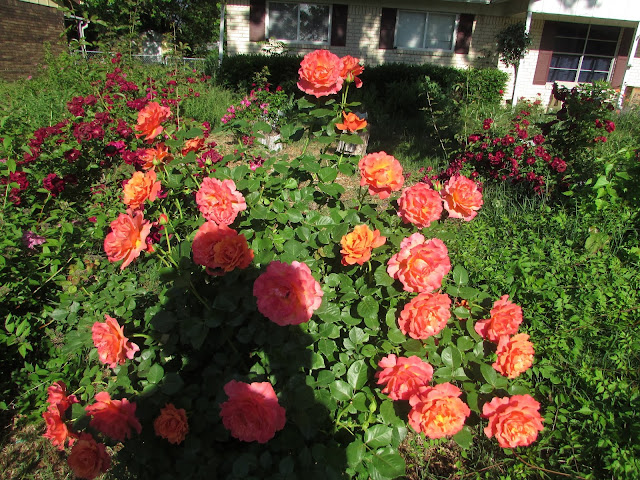 |
| This Chaste Tree shrub has no problems with being pruned or being moved. |
Surprises - especially the pleasant ones - are common in the Creation Garden.
This year is full of wonders, because the rainfall has been generous, but so has the sunshine. Before I can empty the rainbarrels, they are overflowing again. Nevertheless, I empty them regularly to prevent skeeters.
Almost Eden got me involved in shrubs, so I now have two fully developed Chaste Trees and two little ones. The little ones came from fearing I killed one from a move in dry weather. Once the replacement came, the dead one was thriving. Chaste Tree has a definite medicinal smell; its deep blue flowers are enticing to bees and striking to neighbors. Our neighbor Mrs. Gardener said, "What is that beautiful plant?"
 |
| Joe Pye is easy to grow, if watered in dry spells. I order mine early from Growthers Exchange. |
Joe Pye came up so often on butterfly plant lists that I bought a group of them from The Growers Exchange, the only plant source I trust now. They were slow to impress, but last year the senior example soared to 7 feet, filled the air with its scent, and attracted butterflies constantly. The junior class is looking robust, and even the new Little Joe Pyes are budding in time. Little Joe Pye was developed for those who do not want a giant in the garden, so it is more of a flower box plant.
 |
| Our first Mountain Mint was buried by accident under cardboard and mulch, but burst through later to flourish and spread. |
Mountain Mint, which also drives insects crazy, arrived as a tiny plant. This year two large areas are ready to bloom at about five feet in height.
 |
| Cats love Cat Mint, a mint that grows in circumference but does not go wild with roots. |
Cat Mint grows low, but two plantings have grown in circumference and bloomed very early to host the bees and tiny beneficial insects most people ignore or swat away. My plan for dry weather is to plant some dug from the mother ship around the maple, to have a colorful circle in an area which favors weedy growth.
Almost Eden sold me 17 Spirea bushes (Neon) for about $1.50 each. They were small but hardy, planted as the fence around the rose garden, which expanded beyond them. The result has been that the Spirea, mints, and Joe Pyes have grown almost together, but leaving room for roses to grow and soak up the sun.
Fever Few grew to five feet and bloomed. It was just a tiny flower when I grew it in Midland, where it spread to every bare spot. The moment it bloomed, beneficial insects were on it.
Shasta Daisies, the dandelion of flowers, grew from two plants and my efforts at dividing them. They are fully budded and just starting to bloom. Tachinid Flies love daisies - and those flies love killing aphids.
 |
| A wise gardener praises his neighbor's Hotas, which have to be thinned. What better way to increase these natural Hummingbird feeders? |
When I planted Hostas, I feared that rabbits would devour them. The current herd of cute bunnies suggests some sampling of all the plants, but no big losses. The Hostas are robust and blooming, ready to be divided later. I was going to do that in the fall but decided to let them have their leap year first:
- Planting new ones, keep them alive year.
- Second year, sleep year.
- Third year, leap year, which is true of many shrubs.

